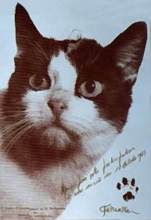
The “race into outer space” was rocketing ahead at full throttle in the 1960s with the world’s two great superpowers running neck and neck in this impassioned contest for cosmic bragging rights. Humankind had surpassed all of its inner atmospheric goals and was ready to leap forward into the last great frontier. Man and beast have always worked well together in pushing back pesky perimeters and confining constraints, with beast often leading the way. The journey into the great unknown of space was no different, with hundreds of animals preceding astronauts and cosmonauts into space, testing the environment and delivery vehicles to ensure human safety.
The Soviet Union enlisted the aid of dogs for trial runs of space systems, while the United States favored the more humanlike chimpanzees and monkeys. The little dog Laika and the gregarious chimp Hamm became the stars of early space exploration, with Laika earning the title of the first living being in orbit, and Hamm proudly completing a test run in the Mercury capsule. But where were those most clever cats while the Soviet and American space agencies were monkeying around and eyeing the moon? Did they get left out in the cold of space exploration?
The Sahara Desert is far from cold, and in the 1960s, it was home to France’s Hammaguir launch facility in Algeria. France was launching rockets from Hammaguir as far back as 1952, and in the early ‘60s, the Centre d’Enseignement et de Recherches de Médecine Aéronautique (CERMA), began experimenting on the biological effects of space flight. With mutts and chimps already basking in the limelight of astronautical stardom, it was time for the advent of a new flying hero: Felicette the Cat.
The black and white feline was a stray whisked off of the streets of Paris. One day scrounging for food out of garbage bin, and the next serving as France’s astrocat, surrounded by fanfare and state-of-the-art high-tech gadgetry. Felicette reported for duty with several other strays, and after strenuous examinations that included time in a centrifuge, it was decided that she was the perfect choice to join canines and primates in the chronicles of space exploration.
October 18th, 1963 was the date set for Felicette’s launch. Electrodes were attached to her skull to measure neurological impulses for CERMA while Felicette rocketed through the sky. Sealed into the nose cone atop a Veronique rocket, flight number AGI47 blasted France’s newest space hero into the blue for a ride that achieved an altitude of 96 miles for a suborbital flight (50 miles is considered to be the barrier of space). After reaching apogee, the Veronique’s nose cone separated and parachuted back to earth, with an onboard radio beacon guiding Felicette’s ground crew to her recovery site.
Felicette’s history-making rocket ride contributed valuable information to France’s space program, and earned her the honor of being the only cat to have ventured into outer space and live to meow about it. Sadly, six days later, in a bid to become the second feline to visit the final frontier, one of her associate astrocats reminded us all just how dangerous and risky space travel truly can be. The brave little space adventurer died on impact when the recovery system on the space capsule failed.
France never developed a space program worthy of challenging NASA or its Soviet counterpart, which factors into why Felicette never got her due. Appearing on postage stamps, the legend of Laika the space dog lives on in the memory of many, and NASA’s monkeys were the darlings of the press. The media outside of France largely ignored Felicette, but nevertheless, the fearless feline was happy enough to be the first and only astrocat, retiring quietly into the annals of space history.
For the Best the Pet Lifestyle and health has to offer follow Wendy and Lucky Diamond on Facebook, Twitter, and right here at AnimalFair.com!
